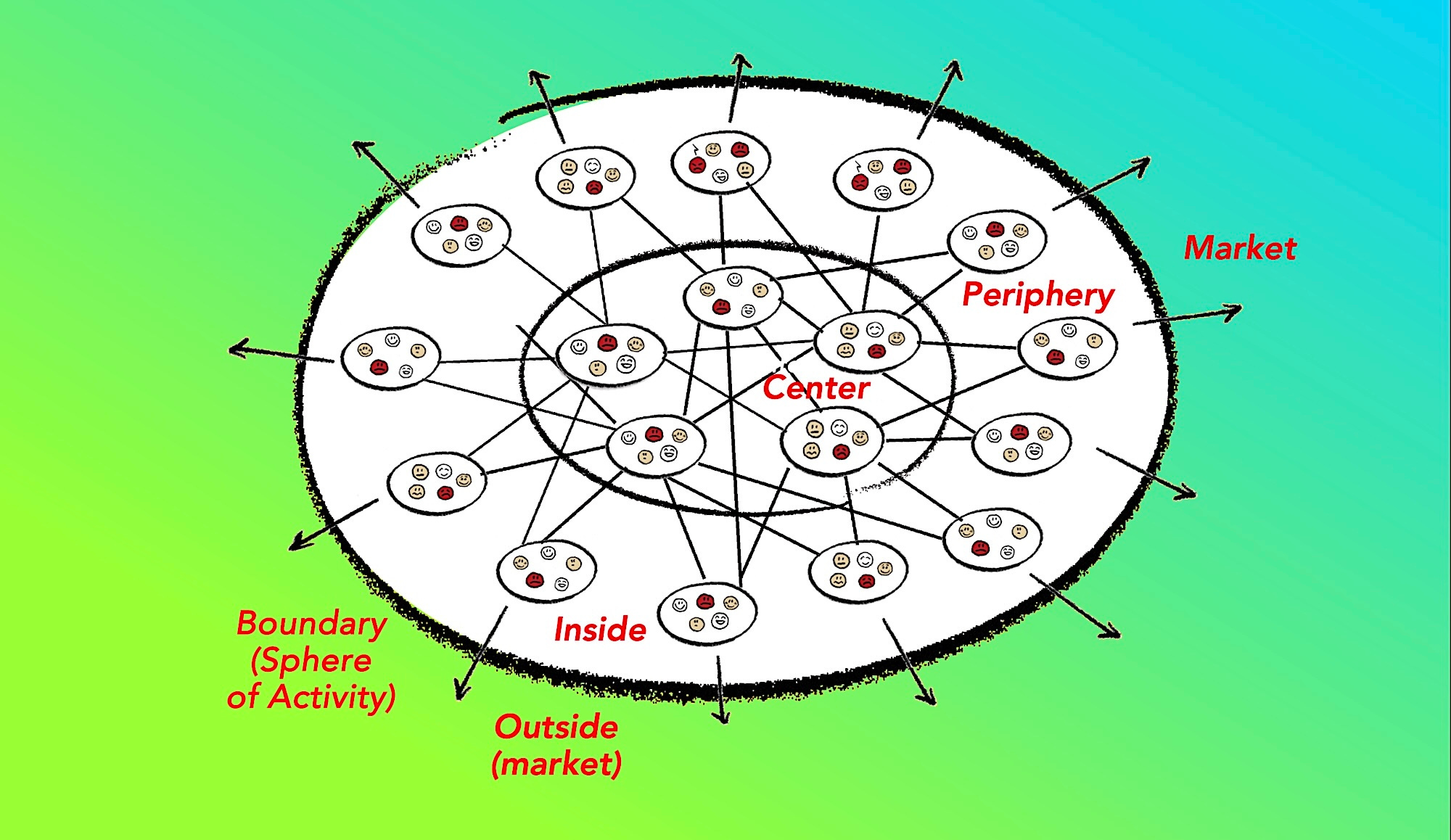Decentralize, repeat: A brief history of Cell Structure Design
Organizational decentralization, or federalization, has never been this tempting
by Niels Pflaeging
2000 to 2008: Origins of Cell Structure Design in Beyond Budgeting – a growing understanding of decentralization
Back in the early 2000s, long before agile software development became a fashionable topic of general interest, the British-American think tank called the Beyond Budgeting Round Table (BBRT) set out to explore modern ideas of “adaptive” corporate management. The research group's approach to contemporary, vital organizational culture was pragmatic: first of all, it tried to identify flourishing companies from all over the world that had already completely dispensed with annual planning, budgeting, fixed targets and centralized control. They started visiting companies in 1999, writing up case studies of their visits, and then reporting back to the BBRT’s membership.
Among the companies identified by the BBRT in this way during the first years of research were Borealis and Rhodia, but also not-for-profit organizations such as Sight Savers International. The breakthrough in the group's case study research work came with the case of leading Swedish bank Handelsbanken, in 2000. It was the first of the BBRT’s case studies in which the full set of “Beyond Budgeting principles" were encountered in a fully pronounced way. Later, other impressive case studies of management ‘beyond planning and control’ were identified, dm-drogerie markt, Toyota, Semco, Gore, Southwest Airlines, Dell and Guardian Industries among them.
We became aware that the concept of decentralization, not certain performance processes, were the cornerstone of high-performance organizing
What distinguished Handelsbanken and the latter case studies from other cases was that these firms had recognized organizational decentralization and consistent self-organization as the basis for a thriving, entrepreneurial organizing. Basically, the BBRT (of which I was a director from 2003 to 2007) found more answers in company cases like that of Handelsbanken than it had ever dreamed of. We gradually uncovered a series of patterns that went far beyond different kinds of planning and forecasting, and beyond mere performance management.
In particular, the radical decentralization of decision-making at Handelsbanken other companies got my BBRT colleague Robin Fraser and me firmly convinced that decentralized organizational structure (not certain performance processes) had to be the key to high-performance organizing. That an organization built according to federative and decentralized organization design principles could completely dispense with central steering, naturally, was a major insight won around 2000 and 2001. The real-world company cases also taught us at the BBRT that the solution to agility and high performance lay in creating a maximum of decision-making authority in functionally integrated, consistently market-oriented, maximally autonomous units in the periphery. And with the organizational center serving, but not steering the periphery.
We understood that traditional organizational design approaches like matrix structures, business unit structures, or even the so-called Spotify model systematically limit cooperation, autonomy and a stifle a sense of community through ‘functional division’. Such approaches to org design even eliminate the need for agreement and discourse to a large degree. Decentralized organizational design, on the other hand, not only promotes agreement and discourse. It also elevates cooperation and team autonomy to a design principle – all that through maximum functional integration within small teams. Unique to this approach is the clear distinction between periphery and center, and thus the emphasis on decentralization: Cell Structure Design is the only approach to organizational design to date that is consistently geared towards federative, decentralized and thus ‘radically democratic’ leadership.
2008 to 2019: Substantial new conceptual insights and practical application
But first things first. In 2008, together with the recently founded BetaCodex Network, we published a research paper on decentralized organizational design - enriched with several case studies. This paper was entitled Turn your company outside-in!
Together with my partner Silke Hermann, I developed the concept further from 2009 onwards. In the following years, we supported around two dozen companies as consultants in decentralization – from law firms to airlines, from medium-sized production companies to major banks, from public utilities to construction companies.
At the same time, we also pushed ahead with our research work: in 2011, we published the concept of organizational physics (Org Physics), which quickly attracted international attention beyond the German-speaking world. The first research paper on Org Physics has reached almost 100,000 readers to date.
My book Organize for Complexity, published in 2014, presented the key concepts of decentralized organizational design in an unprecedented graphic form. The book sold over 30,000 copies in the German-speaking countries alone and has been translated into five languages to date – English, Spanish, Portuguese, French and Turkish.
2019: From concept to social technology – and towards a robust method of realization
In 2019, shortly after founding our joint company Red42, Silke Hermann and I published Cell Structure Design as a ‘social technology’ in its own right. A great thing about Cell Structure Design becoming socio-tech is that it is now freely available for everyone to use, thanks to conceptual codification in a concept and set of principles, which is combined with an open source license.

So although we at Red42 offer a range of services and products related to Cell Structure Design, the approach itself is all concepts and documents related to this kind of decentralized org design are freely available and free to use – without restrictions of access. Nobody has to get certified by us to use Cell Structure Design (even though we offer qualifications). Commercialization of Cell Structure Design is explicitly allowed - as long as there is appropriate referencing to the approach and its creators. Publication of an easy-to-read, clearly illustrated handbook on Cell Structure Design in English is under way: The book’s German-language version was already published in 2020)., and several posters are available.
Cell Structure Design: It’s open source and free to use
In our project work with corporate clients since 2019, we have proven that Cell Structure Design can be implemented surprisingly quickly, and we have published several research papers about the patterns we discovered by performing this kind of work.
Silke Hermann explains the transformational and swift approach that she has applied in her work around Cell Structure Design: “While most experts believe that transformation takes a long time and requires many external consultants, the Cell Structure Design approach relies on more than just involvement or participation. It’s far more effective and more lasting when companies transform their structures themselves. The advantage of this is that the level of commitment is much higher than with the usual takes on restructuring or change management.” Silke asserts: “The realization of the Cell Structure Design in an organization - and thus the consistent abandonment of departmental and divisional structures, centralization and functional division - can be achieved anywhere in 12 weeks. For small organizations with up to 30 people, it can even a little quicker.”
In complexity, decentralization is inevitable, as market forces demand it. The question is not if you want to decentralize or not, but how quickly and how intelligently your organization responds to markets forces that already exert massive market-pull on you and your competitors.
The connection between decentralization and achieving an entrepreneurial company culture was a groundbreaking insight that is one of the strongest drivers for our work: “Around the time we developed Org Physics theory, it became clear to me that the idea of federalizing companies can unhinge the world of corporate governance for companies of any kind. And with it perhaps the world as a whole. Organizational democracy is inconceivable without decentralization. And what is contemporary organizational development supposed to bring if not more democracy in the world of work?” says Silke. “Through case study research and project work, we were able to prove that this type of organizing is clearly economically superior to that with centralized control and steering. It is also clearly superior from a humanistic, ethical point of view: federative organization enables self-determined ways of working that are appropriate to human nature and a far better exploitation of human skills and potential.” In other words, all organizations in the world deserve to be decentralized and to adopt a Cell Structure Design.
Visit the Cell Structure Design resource page: www.cellstructuredesign.com
Watch a related episode of BetaCodex LIVE






